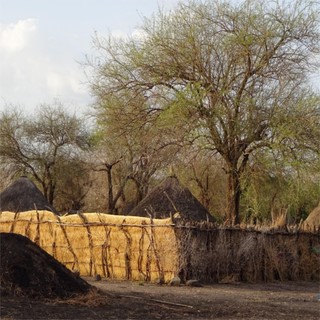
Visceral Leishmaniasis is a parasitic disease in humans that attacks the internal organs of those who contract it and is fatal if left untreated. The diagnosis and treatment is difficult and cost prohibitive for poor families. There is no vaccine. East Africa has the world’s highest incidence of VL transmitted through bites from female sand flies (Phlebotomus orientalis). Globally 31,000–90,000 new cases are reported each year.
Dr. Dia-Eldin Elnaiem, a tenured professor in University of Maryland Eastern Shore’s Department of Natural Sciences, and a group of colleagues were recently featured on the cover of PLOS Neglected Tropical Diseases for a pilot study conducted in rural villages in Sudan. It is the culmination of four years of research.
The journal described their work as “pioneering entomological studies demonstrating that a single application of residual insecticide to boundary fences and hut exterior walls results in an 83-99% reduction in vector numbers over the short sand fly season.”
In Sudanese villages where the disease is endemic, people live in grass huts surrounded by tall thatched reed fences. Uncomfortably high temperatures during the VL transmission season forces residents to sleep outdoors in their yards without bednets where they are exposed to bites from the insect, Elnaiem said. The flies are a highly exophilic/exophagic species that pose a major challenge to current management of VL.
Their journal article, “Outdoor Residual Insecticide Spraying (ODRS), a new Approach for the Control of the Exophilic Vectors of Human Visceral Leishmaniasis: Phlebotomus orientalis in East Africa,” outlined their study that evaluated the application of deltamethrin insecticide and its effects on sand fly numbers during three experiments over some 2,000 trap nights.
“The study demonstrated the feasibility and high entomological efficacy of spraying the outside of the huts and fences (ODRS) and spraying the boundary fences alone (RODRS) and the low cost relative to current practices,” Elnaiem said.

Costs for ODRS and RODRS delivery were $5.76 and $3.48 per household, respectively. Current practices, he said, involve inside residual spraying of insecticides and use of insecticide-treated bednets, which are not as effective since the insect inhabits outdoors where the residents sleep.
The World Health Organization headquartered in Geneva facilitated the study. It was financially supported by the United Kingdom’s Department for International Development and the KalaCORE consortium. According to Elnaiem, colleagues at the World Health Organization in Khartoum, the KalaCORE administration at Mott Mac Donald (UK) and the universities of Khartoum, Gezeira and Gedarif in Sudan helped facilitate the logistics and fieldwork. For more visit, https://doi.org/10.1371/journal.pntd.0008774
Gail Stephens, agricultural communications and media associate, School of Agricultural & Natural Sciences, University of Maryland Eastern Shore, 410-621-3850, gcstephens@umes.edu.

